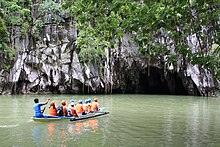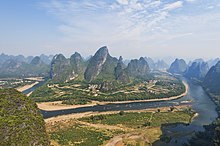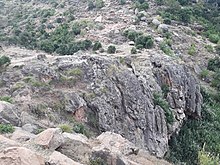Global distribution of major outcrops of carbonate rocks (mainly limestone, except evaporites)
Karst is a topography formed from the dissolution of soluble rocks such as limestone, dolomite, and gypsum. It is characterized by underground drainage systems with sinkholes and caves. It has also been documented for more weathering-resistant rocks, such as quartzite, given the right conditions.
Subterranean drainage may limit surface water, with few to no rivers or
lakes. However, in regions where the dissolved bedrock is covered
(perhaps by debris) or confined by one or more superimposed non-soluble
rock strata, distinctive karst features may occur only at subsurface
levels and can be totally missing above ground.
The study of karst is considered of prime importance in petroleum geology because as much as 50% of the world's hydrocarbon reserves are hosted in porous karst systems.
Etymology
The English word karst was borrowed from German Karst in the late 19th century, which entered German much earlier.
According to one interpretation the term is derived from the German
name for a number of geological, geomorphological, and hydrological
features found within the range of the Dinaric Alps, stretching from the northeastern corner of Italy above the city of Trieste (at the time part of the Austrian Littoral), across the Balkan peninsula along the coast of the eastern Adriatic to Kosovo and North Macedonia, where the massif of the Šar Mountains begins, and more specifically the karst zone at the northwestern-most section, described in early topographical research as a plateau, between Italy and Slovenia.
In the local South Slavic languages, all variations of the word are derived from a Romanized Illyrian base (yielding Latin: carsus, Dalmatian Romance carsus), later metathesized from the reconstructed form *korsъ into forms such as Slovene: kras and Serbo-Croatian: krš, kras. Languages preserving the older, non-metathesized form include Italian: Carso, German: Karst, and Albanian: karsti; the lack of metathesis precludes borrowing from any of the South Slavic languages, specifically Slovene. The Slovene common noun kras was first attested in the 18th century, and the adjective form kraški in the 16th century. As a proper noun, the Slovene form Grast was first attested in 1177.
Ultimately, the word is of Mediterranean origin. It has been suggested that the word may derive from the Proto-Indo-European root karra- 'rock'. The name may also be connected to the oronym Kar(u)sádios oros cited by Ptolemy, and perhaps also to Latin Carusardius.
Early studies
Karst limestones as statuary in Shenyang Imperial Palace, Shenyang, China
Johann Weikhard von Valvasor, a pioneer of the study of karst in Slovenia and a fellow of the Royal Society for Improving Natural Knowledge, London, introduced the word karst to European scholars in 1689, describing the phenomenon of underground flows of rivers in his account of Lake Cerknica.
Jovan Cvijić
greatly advanced the knowledge of karst regions, so much that he became
known as the "father of karst geomorphology". Primarily discussing the
karstic regions of the Balkans, Cvijić's 1893 publication Das Karstphänomen describes landforms such as karren, dolines and poljes. In a 1918 publication, Cvijić proposed a cyclical model for karstic landscape development. Karst hydrology emerged as a discipline in the late 1950s and early 1960s in France. Previously, the activities of cave explorers, called speleologists, had been dismissed as more of a sport than a science, meaning that underground karstic caves and their associated watercourses were, from a scientific perspective, understudied.
Chemistry
The development of karst occurs whenever acidic water starts to break down the surface of bedrock near its cracks, or bedding planes. As the bedrock (typically limestone or dolomite)
continues to degrade, its cracks tend to get bigger. As time goes on,
these fractures will become wider, and eventually a drainage system of
some sort may start to form underneath. If this underground drainage
system does form, it will speed up the development of karst formations
there because more water will be able to flow through the region, giving
it more erosive power.
Dissolution mechanism
The carbonic acid that causes karstic features is formed as rain passes through Earth's atmosphere picking up carbon dioxide (CO2), which dissolves in the water. Once the rain reaches the ground, it may pass through soil that can provide much more CO2 to form a weak carbonic acid solution, which dissolves calcium carbonate. The primary reaction sequence in limestone dissolution is the following:
H2O + CO2 → H2CO3 CaCO3 + H2CO3 → Ca2+ + 2 HCO−
3
In particular and very rare conditions such as encountered in the past in Lechuguilla Cave in New Mexico (and more recently in the Frasassi Caves in Italy), other mechanisms may also play a role. The oxidation of sulfides leading to the formation of sulfuric acid can also be one of the corrosion factors in karst formation. As oxygen (O2)-rich surface waters seep into deep anoxic karst systems, they bring oxygen, which reacts with sulfide present in the system (pyrite or hydrogen sulfide) to form sulfuric acid (H2SO4). Sulfuric acid then reacts with calcium carbonate, causing increased erosion within the limestone formation. This chain of reactions is:
H2S + 2 O2 → H2SO4 (sulfide oxidation) H2SO4 + 2 H2O → SO2−
4+ 2 H3O+ (sulfuric acid dissociation) CaCO3 + 2 H3O+ → Ca2+ + H2CO3 + 2 H2O (calcium carbonate dissolution) Ca2+ + SO42- → CaSO4 (formation of calcium sulfate) CaSO4 + 2 H2O → CaSO4 · 2 H2O (formation of gypsum)
This reaction chain forms gypsum.
Morphology
The karstification of a landscape may result in a variety of large-
or small-scale features both on the surface and beneath. On exposed
surfaces, small features may include solution flutes (or rillenkarren), runnels, limestone pavement (clints and grikes), collectively called karren or lapiez. Medium-sized surface features may include sinkholes or cenotes (closed basins), vertical shafts, foibe (inverted funnel shaped sinkholes), disappearing streams, and reappearing springs. Large-scale features may include limestone pavements, poljes, and karst valleys. Mature karst landscapes, where more bedrock has been removed than remains, may result in karst towers, or haystack/eggbox landscapes. Beneath the surface, complex underground drainage systems (such as karst aquifers) and extensive caves and cavern systems may form.
Erosion along limestone shores, notably in the tropics,
produces karst topography that includes a sharp makatea surface above
the normal reach of the sea, and undercuts that are mostly the result of
biological activity or bioerosion at or a little above mean sea level. Some of the most dramatic of these formations can be seen in Thailand's Phangnga Bay and at Halong Bay in Vietnam.
Calcium carbonate dissolved into water may precipitate out where
the water discharges some of its dissolved carbon dioxide. Rivers which
emerge from springs may produce tufa
terraces, consisting of layers of calcite deposited over extended
periods of time. In caves, a variety of features collectively called speleothems are formed by deposition of calcium carbonate and other dissolved minerals.
Hydrology
Features typical of well-developed karst terrain
Farming in karst areas must take into account the lack of surface
water. The soils may be fertile enough, and rainfall may be adequate,
but rainwater quickly moves through the crevices into the ground,
sometimes leaving the surface soil parched between rains.
A karst fenster (karst window) occurs when an underground stream emerges onto the surface between layers of rock, cascades
some distance, and then disappears back down, often into a sinkhole.
Rivers in karst areas may disappear underground a number of times and
spring up again in different places, usually under a different name
(like Ljubljanica, the river of seven names). An example of this is the Popo Agie River in Fremont County, Wyoming. At a site simply named "The Sinks" in Sinks Canyon State Park, the river flows into a cave in a formation known as the Madison Limestone and then rises again 800 m (1⁄2 mi) down the canyon in a placid pool. A turlough
is a unique type of seasonal lake found in Irish karst areas which are
formed through the annual welling-up of water from the underground water
system.
Water supplies from wells
in karst topography may be unsafe, as the water may have run unimpeded
from a sinkhole in a cattle pasture, through a cave and to the well,
bypassing the normal filtering that occurs in a porous aquifer.
Karst formations are cavernous and therefore have high rates of
permeability, resulting in reduced opportunity for contaminants to be
filtered. Groundwater in karst areas is just as easily polluted as surface streams. Sinkholes have often been used as farmstead or community trash dumps. Overloaded or malfunctioning septic tanks in karst landscapes may dump raw sewage directly into underground channels.
The karst topography also poses difficulties for human
inhabitants. Sinkholes can develop gradually as surface openings
enlarge, but progressive erosion
is frequently unseen until the roof of a cavern suddenly collapses.
Such events have swallowed homes, cattle, cars, and farm machinery. In
the United States, sudden collapse of such a cavern-sinkhole swallowed
part of the collection of the National Corvette Museum in Bowling Green, Kentucky in 2014.
Interstratal karst
Interstratal
karst is a karstic landscape which is developed beneath a cover of
insoluble rocks. Typically this will involve a cover of sandstone overlying limestone strata undergoing solution. In the United Kingdom for example extensive doline fields have developed at Cefn yr Ystrad, Mynydd Llangatwg and Mynydd Llangynidr in South Wales across a cover of Twrch Sandstone which overlies concealed Carboniferous Limestone, the last-named having been declared a site of special scientific interest in respect of it.
Kegelkarst
Kegelkarst is a type of tropical karst terrain with numerous cone-like hills, formed by cockpits, mogotes, and poljes
and without strong fluvial erosion processes. This terrain is found in
Cuba, Jamaica, Indonesia, Malaysia, the Philippines, Puerto Rico,
southern China, Myanmar, Thailand, Laos and Vietnam.
Pseudokarst
Pseudokarsts are similar in form or appearance to karst features but are created by different mechanisms. Examples include lava caves and granite tors—for example, Labertouche Cave in Victoria, Australia—and paleocollapse features. Mud Caves are an example of pseudokarst.
Paleokarst
Paleokarst
or palaeokarst is a development of karst observed in geological history
and preserved within the rock sequence, effectively a fossil karst.
There are for example palaeokarstic surfaces exposed within the Clydach
Valley Subgroup of the Carboniferous Limestone sequence of South Wales which developed as sub-aerial weathering
of recently formed limestones took place during periods of
non-deposition within the early part of the period. Sedimentation
resumed and further limestone strata were deposited on an irregular
karstic surface, the cycle recurring several times in connection with
fluctuating sea levels over prolonged periods.
Karst areas
Lunan Stone Forest, Yunnan, China
The world's largest limestone karst is Australia's Nullarbor Plain. Slovenia has the world's highest risk of sinkholes, while the western Highland Rim in the eastern United States is at the second-highest risk of karst sinkholes.
Mexico hosts important karstic regions in the Yucatán Peninsula and Chiapas.
The South China Karst in the provinces of Guizhou, Guangxi, and Yunnan provinces is a UNESCO World Heritage Site.
The Tham Luang Nang Non karstic cave system in northern Thailand was made famous by the 2018 rescue of a junior football team.
- Abîme, a vertical shaft in karst that may be very deep and usually opens into a network of subterranean passages
- Cenote, a deep sinkhole, characteristic of Mexico, resulting from collapse of limestone bedrock that exposes groundwater underneath
- Doline, also sink or sinkhole, is a closed depression draining underground in karst areas. The name "doline" comes from dolina, meaning "valley", and derives from South Slavic languages.
- Foibe, an inverted funnel-shaped sinkhole
- Karst fenster ("karst window"), a feature where a spring emerges briefly, with the water discharge then abruptly disappearing into a nearby sinkhole
- Karst spring, a spring emerging from karst, originating a flow of water on the surface
- Limestone pavement, a landform consisting of a flat, incised surface of exposed limestone that resembles an artificial pavement
- Losing stream, sinking river or ponornica in South Slavic languages.
- Polje (karst polje, karst field), a large flat specifically karstic plain. The name "polje" derives from South Slavic languages.
- Ponor, same as estavelle, sink or sinkhole in South Slavic languages, where surface flow enters an underground system
- Scowle, porous irregular karstic landscape in a region of England.
- Turlough (turlach), a type of disappearing lake characteristic of Irish karst.
- Uvala, a collection of multiple smaller individual sinkholes that coalesce into a compound sinkhole. The term derives from South Slavic languages (many karst-related terms derive from South Slavic languages, entering scientific vocabulary through early research in the Western Balkan Dinaric Alpine karst).











